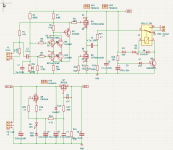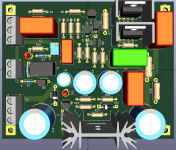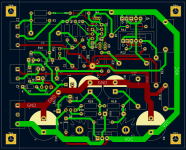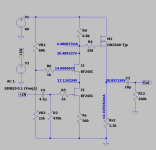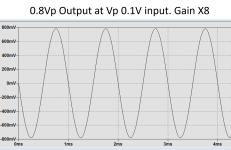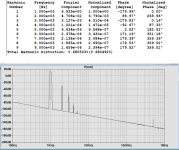I designed a multi-configurable PCB board for the WOTS pre. It can do all the versions of marigno's wots pre-amplifiers, from the original Wots Tree to the Talia by omitting/adding some components. The board can also use B244/245/Lsk489/other popular NJFET, and all most any popular TO220/TO92 MOSFET/JNFET as follower output.
For testing, I also included Shade feedback network.
For testing, I also included Shade feedback network.
Attachments
Last edited:
I know the IXTP01N100D is an expensive transistor, but the cheaper DN2540 didn't work as a CCS in the power supply; perhaps the current we need (1.5mA) is too low. When I changed it to the IXTP01N100D everything worked fine.
I used the IXTP01N100D in the follower and its CCS after reading some @analog_sa 's posts and never used a DN2540 again.
If you want, share your experience with LTSpice using/not using the Sziklai BJT, it is fascinating! The Sziklai solution gives a neutral, perfect sound, but excluding it you get emotion. Health to those who use sunglasses to watch the Monnalisa!
The best dual JFET for a line stage is the LSK489B.
I used the IXTP01N100D in the follower and its CCS after reading some @analog_sa 's posts and never used a DN2540 again.
If you want, share your experience with LTSpice using/not using the Sziklai BJT, it is fascinating! The Sziklai solution gives a neutral, perfect sound, but excluding it you get emotion. Health to those who use sunglasses to watch the Monnalisa!
The best dual JFET for a line stage is the LSK489B.
Thank you! Marigno.
This is the first draft design. I really like to get some critical views for the design. The more, the better. Then it will be refined and improved, including the selection of components, layout of PCB.
I also like your double 6922 concept. It is approved that double JFETs can increase gm, further improve THD and reduce Pd strain put on single component.
If checking specs of BF256B and LSK489B carefully, they are very very similar if not almost same, but higher gm. I also may use BF256B as lower JFET(T12) and Lsk489B as higher JFet(T11), since it has a 60V Vgs(break).
The simulation of your WOTS will be done in the near future. I will post them here.
This is the first draft design. I really like to get some critical views for the design. The more, the better. Then it will be refined and improved, including the selection of components, layout of PCB.
I also like your double 6922 concept. It is approved that double JFETs can increase gm, further improve THD and reduce Pd strain put on single component.
If checking specs of BF256B and LSK489B carefully, they are very very similar if not almost same, but higher gm. I also may use BF256B as lower JFET(T12) and Lsk489B as higher JFet(T11), since it has a 60V Vgs(break).
The simulation of your WOTS will be done in the near future. I will post them here.
Last edited:
I did some simulation of WOTS pre original circuit. I could not find the model for BF244C and ZVNL120A. So I use BF245C and DN2540 in the circuit. BF245 is identical part as BF244 but its noise figure is not specified. Then I put the original numbers of marigno’s circuit, everything in the sim is very close to those with the original.
Since Idss and Vp of the JFET used in the circuit can be different, Rs and Rd have to be modified. Using B-grade JFET, Rs should be reduced and Rd should be increased.
1. Change Rs to get desired J2 Id
2. Change Rd to get output DC close ½ power supply voltage
3. Change Rs2 to get Is for the follower M2
Since Idss and Vp of the JFET used in the circuit can be different, Rs and Rd have to be modified. Using B-grade JFET, Rs should be reduced and Rd should be increased.
1. Change Rs to get desired J2 Id
2. Change Rd to get output DC close ½ power supply voltage
3. Change Rs2 to get Is for the follower M2
Attachments
Initial 0.1Vp 1KHz signal to get the gain. Change the input to get THD at 1Vrms and 5Vrms output. See the pictures. Generally it is H2 dominated. Combined with marigno' selection of the JFET, it is may be the main reason for "Warm Sound".
BF244 is used in amplifier for UHF and VFH, and low noise. Its Ciss and Crss are extremely small around 0.x-2PF. these values are comparable with a tube triode. For instance, 12AX7 has a grid to plated capacitance of 1.6PF and grid to cathode/heater 1.7pf. I remembered a Japanese member in this forum mentioned 2SK168 has the most "airy" sound used in preamp. 2SK168 is used to amplify UHF and VFH as well.
BF244C is tough to find now. But BF256 and BF244 belong to a same category. Its ft is even higher than BF244. I could not find its noise figure. But from the noise-frequency curve at few hundred MHz, its noise should comparable to BF244 if not better. BF256B is still available at Digikey and other major distributors. I bought few ten of them few month ago and tested them briefly. Their Idss are in the range 6mA-10mA. By selecting BF256B with large Idss, it could be used as BF244C in the circuit(I think).
BF244 is used in amplifier for UHF and VFH, and low noise. Its Ciss and Crss are extremely small around 0.x-2PF. these values are comparable with a tube triode. For instance, 12AX7 has a grid to plated capacitance of 1.6PF and grid to cathode/heater 1.7pf. I remembered a Japanese member in this forum mentioned 2SK168 has the most "airy" sound used in preamp. 2SK168 is used to amplify UHF and VFH as well.
BF244C is tough to find now. But BF256 and BF244 belong to a same category. Its ft is even higher than BF244. I could not find its noise figure. But from the noise-frequency curve at few hundred MHz, its noise should comparable to BF244 if not better. BF256B is still available at Digikey and other major distributors. I bought few ten of them few month ago and tested them briefly. Their Idss are in the range 6mA-10mA. By selecting BF256B with large Idss, it could be used as BF244C in the circuit(I think).
Attachments
Last edited:
Another concern to use BF244/245 Jfets in the circuit is their min breaking Vgss figure, which is 30VDC. If WOTS pre uses 60VDC power supply, the max Vgs on the top Jfet can reach 50VDC in the extreme case. From Pass's experiences, JFET can work at much higher Vgs than its breaking Vgs. I tested some J113, too. It is breaking Vgs is 35V but there is no problem to go 70V. So I picked up a BF256B randomly and tested its Id-Vgs curve. It is should be safe when Vgs not over 45V.
Attachments
- Home
- Source & Line
- Analog Line Level
- WOTS Pre-amplifiers
